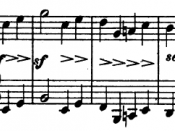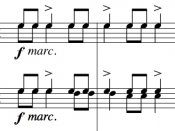Having heard and studied some of Mozart's works, I would say typical Mozart's works are full of scales, that is, quick successions of adjacent notes. This makes his
works sound fleeting in Allegro movements, yet peaceful in the slower movements. Multi-movement works are full of expression. The excitements in the first movements,
serenity in the second, cheerfulness in the third and revival of ecstasy in the last movement. The scales complemented the fleeting, blithe, and spirited nature of his works. This is what I expect to hear too, in Mozart's Duo in B-flat major, and it shows in the concert that it is a typical Mozartiana work. Famous for symphonies, miniature compositions for solo instruments or group instruments (not duo) and operas, instrumental duets are very rare in Mozart's compositions. The duo for violin and viola in B flat was composed in 1783, during which Mozart had already struggled through hardship in his career and entered a life of independent and free from rigors of court life.
I expect to hear happiness and liveliness in this piece of music.
Dvorak's Terzetto in C, was composed in 1887, at that time, Dvorak had already gained international reputation and was invited to England to conduct in concert halls and cathedrals. Soon after he had completed the second set of Slavonic Dances, he composed this Terzetto in C for himself as a violist and his mends to play. I can immediately imagine the large range of tones, the skills the players need to have. I also expected to hear bits of exotic dance-like melodies in the piece, probably in Scherzo.
The concert venue was in Zipper Hall, Colbum School for Performing Arts. The hall is small like a recital hall, no gallery, but there are balcony seats along the two sides of the...


